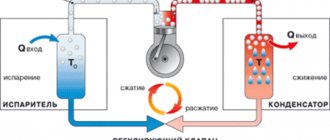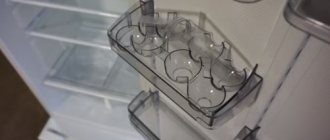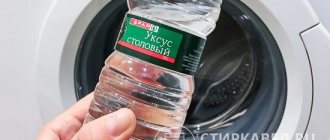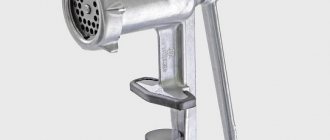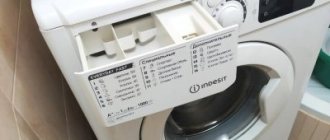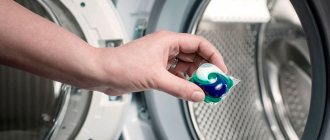Basic Rules
Indesit household refrigerators come in three types:
- devices with a know-frost defrosting system in both chambers (refrigerator and freezer);
- mixed-type appliances (the refrigerator compartment is equipped with a drip defrosting system, the freezer is equipped with a no-frost system);
- units with manual defrosting of chambers.
The rules for defrosting household appliances have some differences, depending on the refrigerator model:
- an old-style refrigerator that is not equipped with an automatic defrosting system requires a mandatory procedure at least once every 1-2 months;
- devices with drip defrosting of the refrigeration chamber and a know-frost system in the freezer require defrosting once every 4-6 months;
- Units in which the frost melting process is fully regulated by the automatic know frost system should be defrosted no more than once a year.
If you notice that a layer of ice has formed in the refrigerator and freezer compartments of the device, regardless of whether you have an old refrigerator model or a modern one (with a know-frost system), the device should be defrosted.
Frost prevents the maintenance of a given temperature in the chambers , as a result of which the risk of premature failure of the motor of an electrical appliance increases many times over.
IMPORTANT! It is advisable to defrost the device in the cool season (autumn, winter, early spring).
This is interesting: how to remove dents on a refrigerator at home.
Possible problems
The operation of the Indesit refrigerator, like any equipment, is associated with the possibility of breakdowns. Some may appear after the unit has defrosted.
Malfunctions of the defrost sensor and timer of the Indesit refrigerator
The defrost sensor of the Indesit refrigerator, which includes a fuse and thermostat, may fail after defrosting. Then the faulty element will require replacement. It is not difficult to check the sensor: the contacts close only at a temperature that is significantly lower than room temperature.
The electronic defrost timer may also need to be replaced. Especially if the defrost sensor is faulty.
Refrigerator does not cool after defrosting
Most often, an electrical appliance does not cool after defrosting due to a compressor failure. In single-compressor refrigerators:
- The cooling does not start, but the lamp in the chamber is functioning.
- The engine hums, but the device does not freeze.
- The light in the main chamber is on, but the motor stops working after starting and both compartments do not cool.
In two-compressor:
- The lighting and one camera are working.
- The motor hums, the equipment does not turn off. The chambers do not get cold or freeze.
- Clicking sounds are heard and the light is on. None of the chambers are cooling.
The reason for the lack of cooling after defrosting is not always due to a compressor failure. In no frost models, malfunctions often occur due to poor quality ice removal.
Problems can also occur if the seal is not tightly sealed.
Auto defrost does not work
Problems with the operation of auto defrost often occur due to a breakdown of the heating element. The malfunction is indicated by flashing indicator lights on electromechanical models and code F07 on electronic ones. Replacing the required element is not always necessary. Sometimes it is enough to check the wires and connections.
If replacement is still necessary, it is better to invite a specialist to diagnose and carry out the appropriate work. If you initially defrost the Indesit Know Frost refrigerator correctly, such problems can be avoided.
detailed instructions
The defrosting process includes several stages, the sequential execution of which ensures rapid defrosting of both chambers.
Do you have an Indesit brand refrigerator?
Not really
Turn off the refrigerator
Set the temperature regulator to position “0”, then disconnect the refrigerator from the power supply : during the defrosting process, the door of the device will be open, while the space of the chambers will be filled with warm air, and the engine will begin to work in increased mode, which can lead to its overheating and breakdown .
In addition, there is a risk of moisture getting on the conductive elements of the device, as a result of which a short circuit or electric shock may occur to the person performing the defrosting.
ATTENTION! After removing it from the socket, it is also advisable to place the plug on some elevation so that droplets of water during operation do not accidentally fall on the part.
Free from food and products
At the next stage, remove all food and food containers stored in it from kitchen appliances and place them in a cool place .
Even if there is very little frost in the refrigerator and it does not take a significant amount of time to remove it, there is a risk that even in such a short period of time the food will have time to spoil.
The temperature of the food in the unit is low, therefore, if you leave food in the chamber during defrosting, the food will “give” cold into the surrounding area, thereby slowing down the defrosting process.
Remove boxes, pallets and grids
After removing the food, remove all vegetable and fruit drawers, egg containers, shelves, and racks in the refrigerator.
This will make removing pieces of melting ice much easier, and don’t forget that all removable elements of the refrigerator also need regular cleaning .
ADVICE! While the household appliance is defrosting, you will have time to wash all the removed parts.
Determine the drainage hole
All refrigerator models are equipped with a drainage system , which is necessary to remove moisture resulting from the melting of frost on the evaporator. The water drain hole is located at the bottom of the rear wall of the refrigerator compartment.
In devices with the no frost system, it is located behind the protective panel at the bottom of the rear wall of the refrigerator compartment.
During the defrosting process, a large amount of moisture will form. To ensure that liquid leaves the chambers freely, be sure to check the condition of the drainage hole; if it is clogged, clean the drain with a special brush or fill a disposable syringe with warm water and forcefully pour it into the drain.
You can learn how to clean the drain hole in your refrigerator here.
Prevent flooding
During defrosting, melt water may escape from the chambers. To avoid causing a flood and damaging the flooring, place old towels and newspapers around the refrigerator, and place rags at the bottom of both chambers .
REFERENCE! Many units also have a drainage tube under the freezer that you can extend slightly and place the end of in a bowl.
Remove ice
You should not wait for the ice to completely turn into water under the influence of warm air.
As soon as you notice that the frost easily comes away from the internal surfaces of the compartments, moisten a soft sponge in warm water and, using gentle movements, without effort, remove the thin snow crust and collect the ice from the bottom .
Wipe off any water that has formed
Once the ice has melted, use a dry cloth or towel to wipe all the internal surfaces of the refrigerator and check the drainage hole again.
ADVICE! Carefully inspect the area around the kitchen appliance for the presence of water, and if necessary, remove moisture.
Wash the refrigerator
After defrosting, you can begin washing the internal and external parts of the device.
Assess the degree of contamination of your device : for minor accumulations of grease and dust, make a weak soap solution (dissolve 1-2 teaspoons of liquid dish detergent in a glass of water) and wash the walls.
After using the cleaning product, wipe the surfaces with clean water and dry them with a towel.
If you are interested in how to clean a No Frost refrigerator, read this publication.
IMPORTANT! Before starting the defrosting procedure, move the refrigerator slightly forward or to the side so that after defrosting you can wash the back wall of the appliance.
Leave to dry
After defrosting and washing, leave the appliance door open for a while to allow all surfaces to dry completely.
If your refrigerator has a manual or drip defrosting type, after drying, close the door, turn on the device and after 1.5-2 hours, return the drawers, containers and shelves to their original places, and load the food.
Equipment with a know-frost system will have to be left turned off for at least 12 hours, and preferably for a day.
IMPORTANT! Ignoring the rule about the procedure for turning on a refrigerator with know frost can lead to failure of the “heart” of the kitchen appliance - the compressor and electric motor.
Checking the seals
The sealing tape ensures a tight fit of the refrigerator door to its body, which helps maintain a low temperature inside the chambers. This element fails quite quickly , since the rubber from which it is made loses its elasticity over time, dries out and becomes cracked.
Signs of a faulty rubber seal:
- the refrigerator starts working with short breaks or continuously;
- the temperature in the chambers exceeds the specified parameters.
You can determine that the seal needs repair in the following ways:
- carefully inspect the closed refrigerator door around the entire perimeter: in places where the tape does not fit tightly to the body, small gaps will be noticeable;
- cut a strip of paper 4-5 cm wide and about 20 cm long, open the door of the device, attach the strip to the body and close the unit (the paper will remain sandwiched between the door and the body). Carefully pull the strip towards you: if the paper cannot be pulled out, the seal is in order.
The rubber band needs regular cleaning:
- if the part is slightly dirty, foam a small amount of dishwashing detergent in water and carefully, using a sponge, wipe all surfaces and folds of the seal;
- If mold and a large amount of grease, dust and crumbs are found in the tape, drop dishwashing gel and 1-2 drops of alcohol onto the sponge and wipe the rubber element.
After treating with cleaning agents, be sure to rinse the tape with water and dry with a towel.
IMPORTANT! To ensure that the element retains its elasticity for as long as possible, after cleaning, rub 2-3 drops of olive oil into its surface with a soft cloth. For the same purposes, you can use silicone grease for rubber engine seals.
Useful video
General defrosting and cleaning of the refrigerator:
The refrigerator is the same household appliance without which, today, it is impossible to imagine any kitchen. And the time that it will serve you directly depends on the technical conditions in which the refrigerator is located and how you look after it.
The instructions for each unit say that every refrigerator needs defrosting. This article describes how to quickly defrost a refrigerator. The only difference is in the frequency of the defrosting process. This depends on the type of cooling system. The frequency of defrosting of a conventional single-chamber is 3–4 times a year, or as snow forms in the freezer. The frequency of defrosting with automatic drip defrosting is 2 - 3 times a year, and with the no frost system 1 - 2 times a year. The defrosting process may take some time, and experts do not recommend speeding up the defrosting process. So how can you quickly and safely defrost a refrigerator? Of course there is a quick way, and not even just one.
How to speed up the process?
You can speed up the melting of ice by using one of several methods that are safe for refrigeration equipment:
- pour hot water into the pan, place the container in the chamber, having previously placed a wooden board under it for cutting food, or fill a medical heating pad with liquid and place the product at the bottom of the freezer or in the refrigerator compartment;
- fan heater or household hair dryer. Place the devices in such a way that the warm air flow emanating from them is directed into the chambers without hitting the sealing element of the equipment. Also make sure that droplets of moisture do not fall on live parts of operating electrical appliances.
IMPORTANT! It is forbidden to remove frost and ice from the walls of the chambers with a knife - the blade can pierce the plastic wall and the capillary tube through which the refrigerant circulates. Such damage leads to freon leakage and the need for equipment repair.
What to do before defrosting
First, the parameters of all thermostats must be set to zero. Secondly, remove the plug from the socket.
Thirdly, clear out food items, shelves and plastic boxes. If something cannot be removed due to frozen ice, then you should not make any effort, but you need to wait a little until the ice thaws, and only then remove it. Fourthly, check the presence of containers for draining condensate under the refrigerator (depending on the model), and be sure to lay a rag around it to prevent water that gets on the floor from spreading.
Well, fifthly, open all the doors, and make sure that during the process of defrosting the system, the doors do not close on their own. The defrosting time of a conventional single-chamber one is approximately 12 hours. A refrigerator with automatic defrosting and a no frost system takes about 2–3 hours. This depends on how much ice it is covered with, on the ambient temperature and on whether you will “help” defrost or not.
Is it possible to defrost a freezer without turning off the appliance?
Many models of Indesit two-chamber refrigerators are equipped with two compressors, due to which each compartment (refrigerator and freezer) is cooled by an individual device. In this case, it is possible to defrost the freezer without disconnecting the unit from the power supply.
To carry out the procedure, it is enough to set the temperature regulator in the chamber to the zero position, remove all products from the freezer and after a certain time remove the melted ice, wipe the walls dry and set the required temperature again.
Find out how to turn on the refrigerator after defrosting, how to properly connect the device to the network.
REFERENCE! Information about what type of refrigerator yours is can be found in the operating instructions for the appliance.
Features of a refrigerator with a No Frost system
The devices maintain the same temperature throughout the chamber. Thanks to the airflow, the cold is restored faster after opening the door.
The method of supplying cold air can be different: regular, vortex or horizontal circulation.
If we are talking about a refrigerator with wind defrosting in both the freezer and main chambers, then there are 2 types of such units. A more efficient design is when each chamber has its own defrosting system. This is how more expensive devices are designed. In cheap models, tubes are installed between them for air circulation.
Read more ► Which refrigerator is better: No Frost or drip, pros and cons
Where should food go during the procedure?
As a rule, when defrosting in the cold season, the problem of placing food from the refrigerator for temporary storage does not arise - it is enough to put them in a large basin or bowls and simply take them out to the balcony or hang them in tight bags outside the window. It’s a completely different matter when it becomes necessary to remove ice during a hot period.
You can preserve food when defrosting the refrigerator in the following ways:
- Using a thermal package. A similar device can be purchased at any large supermarket. The internal surfaces of the product are covered with special foil; between it and the outer walls of the bag there is a layer of penoplex, which allows you to maintain the temperature of the products placed in the device for 2-3 hours. A cooler bag has a similar operating principle, in which you can also put food during the defrosting period.
- Place the food in strong plastic bags and place them in a wide bowl filled with cold water.
- You can simply put food from the freezer in a large bowl, place pre-frozen bottled water in the same place, wrap everything in old newspapers or cover it with a blanket.
REFERENCE! If you are defrosting only the freezer without unplugging the appliance, move the food to the refrigerator compartment during this time.
Pros and cons of No Frost
Wind freezing is considered more modern and progressive; it has a number of noticeable advantages. However, it is not without its drawbacks.
| Advantages | Flaws |
|
|
Attention! The problem of drying out food is easily solved: just store it in the packaging. Moreover, today kitchen units have a compartment for vegetables and fruits.
What to wash after?
You can wash the internal surfaces of the device from various contaminants using improvised means or chemicals:
- pour 2-3 tablespoons of soda into 1 liter of water, mix the components thoroughly and clean the walls of the chamber with the resulting solution, then wipe them with clean water;
- grate a third of a bar of laundry soap, mix the flakes with water and treat the contaminated areas with the product;
- if an unpleasant odor “settles” in the refrigerator, dilute table vinegar in equal proportions with water and wash the chambers with the product;
- cleans surfaces well and removes yellowness from plastic parts 3% hydrogen peroxide and a weak aqueous solution of citric acid (pour half a teaspoon of powder into 200 ml of water);
- Special sprays and liquids (Silit Bang, Top House and others) are effective in removing grease, dust, mold.
IMPORTANT! It is unacceptable to use chemically aggressive compounds and preparations containing abrasive particles to clean the walls of the refrigerator chamber.
Defrosting the freezer and refrigerator compartments of a two-chamber device is a simple and quick process.
Careful and careful handling of the device and compliance with all operating rules of the equipment can significantly slow down the rate of ice formation on the internal walls of the unit and, accordingly, eliminate the need for frequent thawing.
Defrosting 2-chamber refrigerators
How to defrost a two-chamber refrigerator?
The answer is very simple: just like a single-chamber one.
The only caveat here: there are refrigerators whose chambers operate independently of each other. It is very comfortable. When one chamber is defrosting, you can transfer the food to another, and then reload it again and defrost the second one.
Now almost all modern units are equipped with this function.
Even domestically produced Atlant refrigerators have this advantage.
Finish defrosting
After completely defrosting the refrigerator, wash it both inside and outside, and be sure to wipe the inside surface dry. If this is not done, then, if the moisture is not wiped dry, it will turn into ice again. After this, install all the shelves and plastic drawers in their places and, having connected the refrigerator to the power source, adjust the operating parameters you need using either the mechanical thermostat switch knob or using the electronic display (depending on the model).
As soon as the cold reaches the required levels, you can open the refrigerator, put all the food in its place and, closing the doors tightly, complete defrosting.
How to quickly defrost a freezer or freezer
Methods for quick “help” in defrosting
One of the old quick ways is to put hot boiling water in a ceramic or metal bowl, basin or saucepan and place it under the freezer. The rising hot steam will melt the ice that has formed inside. As the container with hot boiling water cools down, you need to replace the cooled water with hot water. And this must be done until the ice has completely melted. This method of how to quickly defrost a refrigerator, although ancient, is one of the safest.
The next quick way is to use a heater equipped with a fan. To do this, it is necessary to place the heating device so that a directed flow of warm air enters the upper part of the refrigerator compartment. The distance from the heater to the refrigerator should be as safe as possible. It is possible to use these two methods of “help” simultaneously to achieve results faster.
The third quick way is mechanical “assistance”. The main thing here, as already written above, is not to “overdo it.”
You can remove pieces of ice and snow not only with your hands, but also with auxiliary tools to help break off the ice. Moreover, the tool should not be metal. You can only use wooden and plastic objects without sharp edges, so as not to damage the surface in any way.
Do not use sharp metal objects

